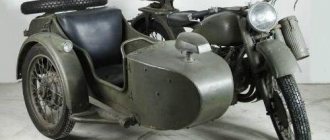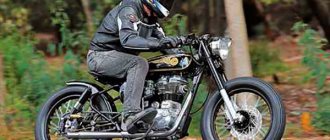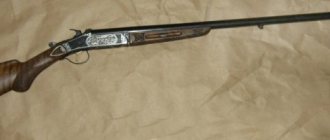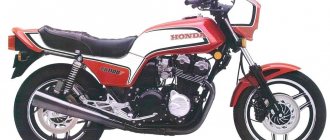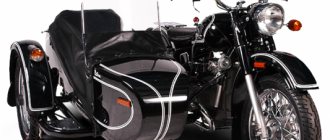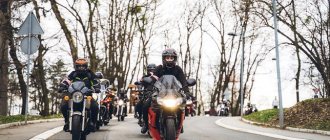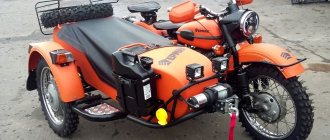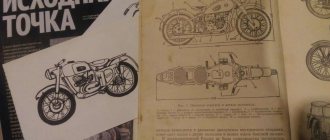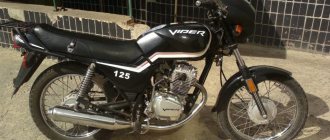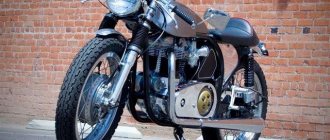Appearing at the beginning of the war years, in 1941, the M 72 motorcycle was copied from the successful German model BMW R71 by the standards of those years. Soviet engineers made a number of changes to the design, making the frame more torsionally stronger, and decided that it would be a great idea to equip the bike not only with a sidecar, but also with weapons. As a result, this steel horse of the Red Army was classified as light armored vehicles, and for a long time was used exclusively for military purposes. It went on sale for free only in the 50s of the 20th century, in a civilian version. The bike was produced at various import sites - MMZ in Moscow, KMZ in Kiev, Irbit in the Urals... It was this bike that served as the prototype of the Ural motorcycle, and of the 8,500 copies some are still on the road.
Design
During the war years, no one thought about the appearance of motorcycles, so the M72 motorcycle turned out the way it should have been - angular, iron and brutal. This fiend of Soviet industry in those years was produced exclusively with a cradle and a machine gun! A civilian version began selling in 1955, featuring a modified engine and minor styling changes, but still capable of mounting weapons if necessary. All owners were even required to register their property with the military registration and enlistment office, since in case of war they could be requisitioned for army needs.
Specifications
Having bought five copies of the BMW P71, Soviet designers took them apart piece by piece and copied them completely without making virtually any changes. The technical characteristics of the bike were fully consistent with their time - the German original worked well in the Wehrmacht, and the Soviet copy in the Red Army. Officially, it was called a “military motorcycle”, and fully corresponded to this description.
Engine
All versions were equipped with a 746 cc 4-stroke 2-cylinder air-cooled boxer engine . For its time it was not bad - 22 hp. at 4600 rpm , and the engine is distinguished by confident traction at low speeds. Even with a sidecar, he is able to pull the bike out of the mud. In a single version, the IMZ M 72 is capable of reaching speeds of up to 110 km/h, and with a sidecar – up to 90 km/h.
Transmission
4-speed transmission for the 40s . Gears can be changed using either a pedal or a lever located to the right of the gas tank, but in modern technology this design has not been used for a long time. It will most likely not be easy to get used to it.
Chassis and brakes
This bike featured a high-tech duplex steel frame and a telescopic fork, which was new at the time (although some examples were equipped with a lever fork). Torque is transmitted to the rear wheel using a driveshaft. The brakes are the most primitive, drum, but they are not afraid of sand or dirt.
Electronics
The designers equipped the M 72 motorcycle with a 6-volt battery and a 45-watt generator. He got the most standard ignition, battery-powered, although the sports versions were equipped with a magneto. Some enthusiasts convert the bike to 12V, but such intervention in the design inevitably entails a lot of other modifications.
Weight and dimensions
The weight of the M72 without a sidecar reaches 225 kg, and with it exceeds 350 kg. Cast iron cylinders, a massive frame, the absence of any plastic - all this made the bike very heavy. The saddle height is moderate, 790mm in stock condition, so most bikers can reach the ground with their feet without any problems.
Controllability
With a sidecar, the bike moves along the roads with the grace of a hippopotamus, just like later Urals. Without it, it steers much better, but you still need to be careful. A rough, bulky frame and extremely simple suspension do not contribute to good maneuverability.
Fuel consumption
The declared gasoline consumption of the M 72 motorcycle is about 7 liters per 100 km, but the actual values directly depend on the condition of the particular instance. The gas tank holds as much as 22 liters, so the bike’s power reserve is not bad in any case, especially since it can run on any gasoline, regardless of its quality and octane number. In those years when it was produced, no one had heard of AI-92, let alone higher octane fuels.
Engine design
The opposed cylinder arrangement ensured good engine balance in combination with a low center of gravity, which was located at a height of 592 mm. Auxiliary working units - a generator, an oil pump, a distributor - rotated using gear drives. The cast iron cylinders were coated with a special black varnish with heat-resistant characteristics. The crankshaft main journals operated on needle bearings. The connecting rods were separated and each sat on its own crankshaft journal. This assumed a horizontal axial displacement of the cylinders of 39.2 mm relative to each other. The double-bearing crankshaft made it possible to reduce the length of the engine crankcase by thinning (up to 18 mm) the cheeks between the main and connecting rod journals.
Repair and tuning
Like all Soviet equipment, this motorcycle is distinguished by its simplicity of design and maintainability. You can maintain and repair it yourself using a minimal set of tools.
Repair
To repair the M72, any garage and a suitcase with tools will do for 3 thousand rubles. The network is full of detailed instructions about all service operations and “diseases” of these bikes, so understanding all the nuances will not be difficult. But they are not highly reliable - in wartime, the equipment did not last long, and making it durable was unprofitable, so all surviving copies of the motorcycle require regular attention and hands-on use.
Spare parts
Original spare parts for this two-wheeled rarity can be found on message boards and owner forums. Many units are suitable from Ural and M61, but not all. The cost of original spare parts varies depending on their prevalence and condition, and can be either cheap or very impressive.
Tuning
There are few M 72 motorcycles left in the world in a condition that can at least conditionally be called alive. Therefore, all those who like to take an ancient bike and build from it another “real chopper” in the best traditions of the “Red Lenin” collective farm, armed with an angle grinder and welding, should be excommunicated for life from the garage and forever deprived of category “A”, and should not be allowed near motorcycles even on a gun shot. Such a rarity should not be tuned, but restored and restored.
Modifications
The M72 was produced in two versions, with and without a sidecar, and the side trailers were equipped with mounts for on-board weapons. If desired, the cradle can be detached, and the motorcycle will not lose its ability to move even without any modifications. During production, minor updates were made, but there was only one major change, in 1956 - the M 72M model went onto production lines. It featured a new cradle, a reinforced reverse gearbox, a modified engine and improved wheels, which became stronger thanks to newly secured spokes.
There were also several sports modifications, but finding them now is almost impossible. Enthusiasts, however, can try:
- M 72K , a lightweight cross-country version with a forced engine. Produced in small batches.
- M 75M . It was a modified version of the previous modification, with a sidecar and an overhead valve engine. Sometimes mistakenly called M72M.
- M 76 . A single (without cradle) version of the regular M 72 motorcycle, also with an overhead valve engine, similar to the one installed on the M 61.
- M 80 . Almost a one-off model, created specifically for competitions.
Story
BMW R71
Motorcycle M-72 in the Vladivostok Antique Automobile Museum
Motorcycle M-72 with a DP machine gun
In the USSR, the decision to produce a special army motorcycle was made at the beginning of 1940. Under the leadership of N.P. Serdyukov, who from 1935 to 1940 underwent an internship at the BMW plant[3], a specialized design bureau for heavy motorcycle construction was created on the basis of the Moscow experimental one. The BMW R71 motorcycle, which by that time had proven itself well in the Wehrmacht, was chosen as a model for complete copying. Five motorcycles were purchased anonymously from Sweden. Since the spring of 1941, the production of a motorcycle under the M-72 brand was launched at the Moscow Motorcycle Plant (MMZ). Through cooperation, ZIS developed documentation and supplied engines, KIM (now AZLK) - gearboxes, GAZ - the driveshaft and sidecar. The Moscow Bicycle Plant produced motorcycles until 1951. Another production base was the Kharkov plant; the Kiev Medical Instruments Plant supplied it with engines. The production of the M-72 was also entrusted to Leningrad. On February 25, 1942, M-72 motorcycles began to be produced in Irbit, where equipment from MMZ, KiM, ATE-1, and the ZiS engine workshop were evacuated. The main design bureau also moved from Moscow to Irbit. It was headed by Alexander Minovich Fedorov, among the designers were I. I. Okunev, N. A. Kukin, V. V. Bekman, testers S. I. Karzinkin and B. V. Zefirov. At the same time, the production of M-72 motorcycles was launched by the Gorky Motorcycle Plant. In parallel with IMZ, starting in 1951, the Kiev Motorcycle Plant (KMZ) began making M-72 motorcycles. Later he embarked on his own path of design development. There were no differences in design (and even in emblems!) among M-72 motorcycles produced in Moscow, Irbit, Leningrad, Kharkov or Gorky. Since 1955, M-72 motorcycles began to be sold to the public. The civilian version of the IMZ plant was distinguished by: an improved engine, reinforced wheels and frame, torsion bar suspension for the sidecar wheels, a new color scheme and the inscription “Irbit” on the tank. However, all these civilian motorcycles were registered with the military registration and enlistment office and were subject to requisition in wartime. 8.5 thousand motorcycles were produced.
Advantages and disadvantages
It is difficult to talk about strengths and weaknesses when we are talking about a motorcycle that was produced 50-70 years ago. For its time and its purposes, the M72 was good, but a lot has changed since then.
Advantages
- Reliable 4-speed transmission , advanced for its time.
- -road ability .
- Phenomenal maintainability . You can literally fix a bike with a hammer and a screwdriver.
Flaws
- Insufficient frame rigidity on early copies. When the stroller is loaded, this can lead to the frame twisting, especially when driving off-road.
- Frequent breakdowns . Soviet designers did not put much resource into military equipment, since during the war it was “consumable”.
- Difficulty finding spare parts , especially original ones.
Owner reviews
When I was a child I had an M72, my first motorcycle. What have I done with it... If I had known then that it was such a rarity, I would have treated it differently. But I still remember with warmth, it was he who instilled in me a love for bikes and turning nuts. Now I would never sell it, sometimes I even think about looking for an option for sale so I can restore it myself, but that’s just a dream. Ivan, Podolsk.
A real Soviet monster!!! No match for the late Urals, which fell apart on the move ten years after their release. The M-72 is like the T-34 tank, only with two wheels, the same cast iron, indestructible and repairable. Dmitry, Tyumen.
The M72 was inherited, it has been in the garage since the late 90s, and over the last couple of years I have been slowly restoring it. The bike is already driving, the original stroller has been purchased and prepared for painting, but the process is going slowly, I only work on it on weekends sometimes, I just don’t have enough time. So far, about 120 tons have been spent on spare parts and work, I think it will take the same amount, but in the end there will be a motorcycle restored to 100% original, with the exception of tires - at least put it in a museum. Favorite weekend toy)) Alexander, Rostov-on-Don.
Due to laziness and vanity, I am posting my own text from the site (the name of the site was killed according to the rules) The people mentioned in the post are forum users (the name of the site was killed according to the rules) I was deprived of motorcycles in my childhood, barefoot... I was also deprived of mopeds... Great " Schoolboy” and he took it from a friend to drive. But... Motorcycle contusion is such a thing. Can be covered at any time. Covered it in general (not on this motorcycle, but that’s another topic). It all started back in 2010... Geez... amazing, I learned this from the file data. Damn, no, it can’t be that this was 5 years ago. Although. Oh, at that time I was picking at another mot. In general, you can’t argue with the facts... In general, here’s the photo when you bought it:
In general, it was a village and quite far from the city. Documents, no, what the hell documents... In general, there were almost no documents for the money. Purchase price 5,000 rubles (village of Suda, Perm region, 2010). A very big plus of this particular motorcycle is that it has had one owner since the first purchase, from whom I bought it. A motorcycle is usually not something that can be “put on the far shelf.” Usually. Five years have gone somewhere. In general, “soon the fairy tale is told, but not soon the deed is done.” There is no photo of the next stage. There was laundering, defectiveness, accumulation of information. At first, even the model itself (the short-link front fork is not a completely ordinary thing) was not immediately identified. I admit, I even tossed around at the beginning... “custom”, “bobber”, “cafe racer”... oh, and I also “saw it on the Internet”... Then it settled down. It's good that it went on the far shelf. Somewhere in the year 13, Anton will correct, if anything, the moto was transported to Anton, aka AnBat, in the garage. (this was my second motorcycle, which Anton worked on). The license plate number of this motorcycle is currently bolted to the door of his garage. I think this is symbolic. Another issue in the series is the city of Molotov. When registering this vehicle, I indicated that the license plate was lost. Well, it's really lost. It would be a sin not to lose such a thing. The following decision was made: No “collective farm” if possible. First, bring the equipment into conditionally “good technical condition.” Finishing it up (disassembling, painting, assembling). Without getting too deep into technical issues. In 2014, the motorcycle was running at the beginning of the season. Full analysis. Engine and gearbox overhaul. Repair everything. Suspension bulkhead. Purchasing a pair of front forks (one working one can only be assembled from several pieces). Ordering parts (the needle bearings of the front fork lever are akin to a mammoth. Everyone has seen it, but it is not alive). Another motorcycle was purchased as a donor of spare parts... and only the engine was removed from it... (although, as a bonus, awesome documents for the M-72 from 1953 “fell out”, but that’s just a bonus). In general, this is a good period of time... Internet, telephone, payments, transport companies, parts, defects... and sometimes: “BL @, all over again...” One way or another, in 2014 I have license plates, with a license, on the road. I drove it to the opening. I still don’t have the skills to ride a motorcycle. But at the same time. Category “A” was discovered by himself. The motorcycle was registered with the state (using the corrupt connections of his friends). Photo. Personally, I really like:
The handles on the steering wheel are different colors. The front wheel is not only a different color, but also from a different motorcycle... But the author of the photo (the photo was taken by accident and unnoticed by me), well done. Here is the photo itself, just like that with character. Random but beautiful. Low bow to the author of the photo. I have never been so beautiful on my own. Well, on departure on the same day:
Time passed. It always “goes”... 2015 neither started nor went according to plan. One way or another, but... The motor was completely disassembled. Additional parts purchased. Sometimes not enough, sometimes too much. Things didn't go according to plan. Actually everything. I generally spent the beginning of the motorcycle season in the hospital, and began preparing for it on the New Year holidays. But the experience of life is an experience that leaves behind a smile of pleasure. In general, it was not easy. Today I took a ride around the city. Myself. Leisurely. With pleasure. Photos for today:
Subtotal. I don’t know how to drive very well, but I take it slowly and it’s good enough. The motorcycle is simply beautiful as a thing in itself. Meditation while riding a motorcycle is achievable. I learned a lot of new things during this project. So many. A lot of just unnecessary stuff. There's just a lot of new stuff. Lots of unusual things. One showdown on the citations... it’s just a separate topic. I'm just glad that I have this “thing” and I am its owner. The joy of ownership. The joy of driving. The project is not finished. There is also a stroller there. There is one (two of them, wings, frames, lanterns... the winter is long). The text is not finished. Important. Tenks was in a hurry. 1) Anton aka AnBat. Hands of the project. Project workshop. Project disputes. Project tips. Garage. Conversations for life. In general, what is in the photo is largely his merit. 2) SiD. Chrome plating. Rare. complex, arduous... But necessary, taking into account the life of the motorcycle, chrome plating of motorcycle parts. 3) Vladimir “Master” Isakov. Correction of wheel rims. This is not the easiest task. Or rather, to put it another way. These wheels can only be fixed there. 4) Painting. everything is very complicated here. “Expensive and Stupid” like Dolce and Gabanna. I don't recommend the place where I painted, but I highly, highly recommend sandblasting in that place. I am ready to discuss this in private messages. 5) “Citations”. Special thanks to Yulia. Links in the topic about circuses. The list is not complete. There are still people to whom I will personally thank you. In general, something like this. The time is over for today... and the bottle of wine... and the mood.
Similar models
- IMZ M 61 . Direct descendant of the M 72, produced for 4 years, from 1957 to 1961. Equipped with an overhead valve engine instead of a lower valve one.
- Ural M 62 . Produced at the Irbit plant from 1961 to 1965, it was distinguished by improved ignition and an increase of 2 hp. motor power.
- Ural-2 M 63 . The first Soviet heavy motorcycle with the then advanced pendulum rear suspension with spring shock absorbers. Produced from 11963 to 1971.
FAQ
- There is my grandfather’s M 72 motorcycle in the garage, but the engine is dead and cannot be restored. Is it possible to put an engine from the Urals into it? With a number of serious modifications, it’s possible. But it will be much easier to try to find an overhead valve engine from the M 61; it will fit into the frame with less difficulty.
- How much can you sell an M72 on the move for? It starts, drives, and is in farm condition. If most of the original spare parts are preserved, then you can count on a price of up to 80-100 thousand. Another thing is that finding a connoisseur willing to buy a bike for restoration can be difficult.
- The oils for which it is designed have not been produced for a hundred years. Which ones are better to use? Any inexpensive motorcycle oil will do. The bike is not picky in this regard.
Electrical equipment of the motorcycle Ural M 72
The electrical equipment of the Ural M 72 motorcycle consists of the following devices and units: a G-11A generator; battery Z-MT-7 or Z-MT-14; relay-regulator RR-31; ignition coils IG-4085-B; breaker-distributor PM-05; spark plugs NA11/11AU; FG-6 headlights, lighting lamps, signal, switches and warning lamp.
The spark plug NA11/11AU is a collapsible type, consisting of: uralite insulator 1; central electrode 4; steel body 2; side electrode 5; insulator nuts 3; two copper gaskets 6; one copper-asbestos gasket 7. The central electrode is covered on top with a carbolite tip 5. The spark gap between the central and side electrodes should be 0.7 mm.
The FG-6 headlight consists of a housing 1, a rim 2 with a lens, a reflector 3 with a double-filament lamp 4 and a parking light lamp 5. The headlight housing contains a central switch 6, a high and low beam switch 7, a speedometer 8, a warning lamp 9 and a fuse 10 The various positions of the central switch are switched on using key 11. There are wire holders on the sides of the headlight housing.
Electrical diagram of the M 72 motorcycle.
1 – double-filament lamp; 2 – ignition key; 3 – fuse; 4 – headlight; 5 – central switch; 6 – reflector wire to ground; 7 – high voltage wire; 8 – candle; 9 – high voltage wire; 10 – ignition coil; 11 – side lamp; 12 – signal; 13 – wire for the rear light of the stroller; 14 – lamps for the rear light of the stroller; 15 – motorcycle taillight lamps; 16 – brake light sensor; 17 – relay regulator; 18 – generator; 19 – battery; 20 – low voltage wires; 21 – battery ground wire; 22 – breaker; 23 – distributor; 24 – high voltage wire; 25 – connecting wires of the breaker with the ignition coil; 26 – signal button; 27 – signal wire; 28 – ignition timing lever; 29 – light switch cable; 30 – light switch; 31 – control lamp; 32 – parking light lamp; 33 – speedometer lighting lamp; 34 – motorcycle-sidecar wire connector; 35 – wire for the rear light of the stroller; 36 – wire for the rear light of the stroller; 37 – Sh, Z and B – relay-regulator terminals.
The design of the remaining electrical devices and units of the Ural M 72 motorcycle is given in the description of the electrical equipment of the K 750 motorcycle.
The required driving tool is shown below.
Return to contents — ↑
Conclusion
The M 72 motorcycle is a wartime product . Even from the photo it is clear that it was designed for one purpose - to be produced as quickly and cheaply as possible. Now there are very few of these veterans left, and if you get your hands on this bike, the best solution would be to either restore it or put it in the caring hands of people who will cope with this task.
Specifications
| Maximum engine power: | 22 l. With. at 4,600 rpm HP |
| Working volume: | 746 cm3 |
| Motor type (cylinder arrangement, number of strokes): | Opposed |
| Number of cylinders: | 2 |
| Number of valves: | |
| Intake type (Injector / Carburetor): | |
| Bore and stroke: | |
| Starting system (Electric starter, kick starter): | |
| Maximum speed in km/h: | 95 km/h |
| Cooling system: | Air |
| Transmission (gearbox): | 4-speed |
| Clutch (Dry / Wet): | |
| Drive unit: | Cardan |
| Frame: | Steel |
| Chassis | |
| Suspension (front/rear travel): | |
| Brakes (Front/Rear): | |
| Wheels / Tires / Rubber: | |
| Dimensions and weight | |
| Dimensions (Length / Width): | |
| Seat height: | |
| Ground clearance: | |
| Curb weight: | |
| Wheelbase: | 1430 mm |
| Weight: | 225/350 kg |
| Fuel tank capacity: | 22 l. |
| Battery capacity: | |
| Year of release: | |
| Country of Origin: |
Engine m 72
The engine of the Ural M 72 motorcycle is a two-cylinder, four-stroke engine; according to its design features, it can be classified as a forced road-type engine (despite the lower valve timing mechanism), since its compression ratio, speed and power are quite high. The engine on heavy motorcycles from the Irbit plant has an opposite arrangement of cylinders in a horizontal plane, which ensures good balancing of the inertial forces of the crank mechanism and reliable cooling. A gearbox is attached to the engine, connected via a clutch.
The cylinders are cast from alloyed or modified cast iron. The valve boxes are cast integrally with the lower cylinder support flanges. The left cylinder is moved slightly forward in relation to the right one. The cylinder heads are cast from aluminum alloy and have double ribbed bottoms for better cooling of the cylinders of the Ural M 72 motorcycle engine. An asbestos-metal gasket is installed between the head and the cylinder.
The pistons are cast from a special aluminum alloy, which contributes to their better cooling. Two compression rings are installed in the upper grooves of the pistons. In the lower groove there is an oil collection ring. The lower groove has through cutouts designed to reduce heat transfer from the head to the piston skirt and to remove oil removed by the oil collection ring from the cylinder walls. The piston rings are made of special cast iron. All rings have straight locks, the gap in which in the working position is 0.25-0.45 mm.
The connecting rods have one-piece heads. Bronze bushings are pressed into the small heads, and single-row roller bearings with cages are inserted into the large ones. The small head is connected to the piston using a floating piston pin. The rollers of the large head roll along the surface of the crankshaft journal, which has two elbows with crank radii of 39 mm. The crankshaft assembly with connecting rods is an integral unit, since its disassembly and reassembly is impossible without special tools.
The durability of this unit is guaranteed by the factory within 15,000 km. When assembled, the shaft is installed in a one-piece crankcase on two ball bearings. To mount the engine to the motorcycle frame, there are special bosses with holes for through bolts in the lower part of the crankcase.
Motorcycle engine M 72 (disassembled). 1 — front crankcase cover; 2 — breather tube; 3 - lock nut; 4 — camshaft oil seal; 5 — oil seal body; 6 — distribution head cover; 7 — breather; 8 — camshaft gear; P - camshaft; 10 — camshaft flange; 11 — camshaft bearing; 12 - sealing gasket; 13 — camshaft bushing; 14 - crankcase; 15 — generator gasket; 16 — generator gear; 17 — connecting rod; 18 — oil pump drive gear bushing; 19 — gear; 20 — gear plug; 21 — generator stop; 22 — valve box cover and gasket; 23 — cover screw; 24 - flywheel; 25 — flywheel pin; 26 — lock washer and flywheel mounting bolt; 27 — bolt and lock washer of the crankshaft gear; 28 — crankshaft gear; 29 — bearing housing cover; 30 - bearing; 31 — bearing housing; 32 - crankshaft; 33 - oil catcher; 34 - sealing gasket; 35 — rear crankshaft bearing housing; 36 — oil seal; 37 — roller bearing separator of the large connecting rod head; 38 — roller; 39 — connecting rod; 40 — connecting rod small head bushing; 41 — piston pin; 42 - piston; 43 — oil scraper ring; 44 - compression ring; 45 — oil line pipe; 46 - defoamers; 47 — crankcase spacer; 48 - sealing ring; 49 - plug; 50 - coupling; 51 — oil pump housing gasket; 52 — oil pump housing; 53 — oil pump gears; 54 — oil pump housing cover; 55 — oil pump filter; 56 - pallet; 57 — pan sealing gasket; 58 — drain plug and sealing washer; 59 — cylinder gasket; 60 — left cylinder; 61 — carburetor gasket; 62 — cylinder head gasket; 63 — cylinder head; 64 — cylinder head mounting bolt; 65 — upper valve spring plate; 66 — valve spring sealing gasket; 67 - valve; 68 — valve spring; 69 — lower valve plate; 70 - cracker; 71 — bolt and locknut of the pusher; 72 — pusher guide; 73 — pusher; 74 — pusher guide bar; 75 — strip pin.
Return to contents — ↑
Motorcycle engine lubrication system Ural M 72
Motorcycle engine lubrication Ural M 72 has a combined lubrication system. The engine is powered by two caburators. The bearings of the large connecting rod heads, the left cylinder and the timing gear are lubricated under pressure. The remaining parts are lubricated by spraying oil with oil mist. The lower part of the engine crankcase is covered with a stamped steel pan, which is a reservoir 19 for oil, the capacity of which is 2 liters.
The Ural M 72 motorcycle engine is lubricated under pressure using a single-stage gear pump 1, driven from the engine camshaft. When the engine is running, gears 2 and 3 drive oil into the main oil line, and from there to two oil catchers 12, to the upper wall of the left cylinder and to the crankshaft drive gear. After this, the oil is sprayed onto the rubbing surfaces of the parts of the crank mechanism and the gas distribution mechanism. A spool breather is mounted in the distribution box housing, rotating together with the camshaft gear and designed to reduce oil pressure in the motorcycle engine crankcase.
Return to contents — ↑
Motorcycle engine power supply Ural M 72
The engine power system of the Ural M 72 motorcycle includes a fuel tank with a capacity of 22 liters, a three-way valve KR-16 and two carburetors K-37 A, which have one common air cleaner, suction and exhaust pipes. Carburetors have the same design, but are not interchangeable (left and right).
The K-37 A carburetor consists of a body, with which the float chamber is cast in one piece. The latter is closed by a lid 3, in which there is a drowner 5. When you press the drowner, the float lowers, the fuel level in the chamber rises, and the mixture entering the engine cylinders is enriched. The power system prepared the motorcycle engine for starting.
To automatically regulate the fuel level in the float chamber, there is a shut-off needle 4, controlled by a hollow float 6. Fuel enters the float chamber until the float floats up together with the shut-off needle, and the latter, with its upper conical end, closes the fitting hole in the float chamber cover . The fitting has a mesh filter 8, designed to filter fuel.
There are two holes at the bottom of the case. The nozzle 10 is screwed into the upper hole, into which, in turn, the main jet 9 is screwed. The fitting 7 with filter 8 is screwed into the lower hole. The nozzle communicates with the mixing chamber through an air channel.
Low speed (idle) jet 13 is screwed into the lower part of the carburetor body. The nozzle is closed from below with a locking screw 21, which is intended for purging the nozzle. Fuel is supplied to the low-speed jet from the float chamber through channel 14, and air is supplied from the air pipe through air channel 16 and an additional channel connected to air filter 17. Air channel 16 is closed by adjusting screw 18 with a lock nut.
Above the sprayer there is a throttle valve 2 with a needle 12 and a spring 23. The valve has a bevel on the side of the air entering the pipe, and on the side surface there are two longitudinal grooves.
The throttle needle enters the internal channel of the main jet nozzle, due to which fuel flows to the nozzle through the annular gap between the wall of the nozzle channel and the needle. There are four holes at the top of the needle. If you combine these holes alternately with two holes in the spool housing, you can get eight different height positions of the needle.
The lower the needle is, the poorer the mixture, and vice versa.
The throttle spool moves along a guide, which is closed on top by a cover 24 and secured with a union nut 25. Spring 23 presses the spool down, and the upward movement of the spool is limited by stop 20. This stop (limiter) during the break-in period does not allow the engine to be given high speeds and overloaded.
Throttle spools are raised or lowered by rotating the throttle knob, which is connected to the spools using cables, in the appropriate direction. Both spools must be actuated and work synchronously, which is achieved by a certain installation of the stops of the cable sheaths 26, followed by tightening the locknuts 27.
Return to contents — ↑
The gas distribution mechanism of the Ural M 72 motorcycle engine
The gas distribution mechanism of the Ural M72 motorcycle engine has a lower (side) valve arrangement.
The camshaft is mounted in the upper part of the crankcase on two bronze bearings (manufactured before 1955). On later motorcycles, the front bronze bearing was replaced by a ball bearing.
The camshaft receives drive from the engine crankshaft through a pair of helical gears.
Five cams are integral with the shaft: two suction, two exhaust and one ignition cam.
The latter serves to open the breaker contacts.
The lifting of the valves during operation of the gas distribution mechanism of the Ural M 72 motorcycle engine is carried out through rectangular flat pushers made of cast iron with bleached working surfaces.
The pushers move in aluminum guide bushings.
Reliable engine operation is guaranteed if there is a thermal gap between the pushrod bolts and the valve stems. This gap for a cold engine should be 0.1 mm.
Return to contents — ↑
